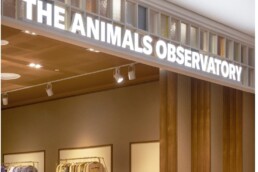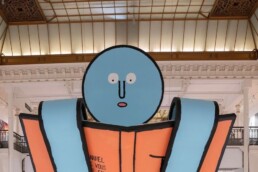Rather poetically, an exhibit at the Museum of Childhood in London has coincided with our house hunting in Porto. For a nomadic family like ours, the idea of settling down can feel like a momentous event. We’ve embarked on this particular adventure en famille. Everyone has their criteria to bring to the search, of course – light, space, architectural appeal. No matter what’s on the viewing agenda, the girls’ favourite always seems to be the last house we visited. Although it was Casa Cão, or The Dog House, that left the most lasting impression. The owners of this house have five children. They also have five dogs. And two cats. And three turtles. And a snake. And a cage full of mice to feed the snake. A veritable Noah’s ark, moored to the Atlantic shore in Porto….
More often, however, visiting these houses has been like stepping onto the pages of Alice in Wonderland. The spaciousness of empty houses gives rise to optical illusions. Empty spaces say “Fill Me!”, and we do. With objects, ideas and even encounters to come. That’s what a dream house is all about, and that’s what got me thinking about doll houses, well before I learned of the V&A exhibit. We have had so many doll houses over the years. There is the Sylvanians mansion, the Lego high-rises, and the dog-eared flea market find from Switzerland, with the real wooden shutters. More recently still, every square foot of our home has become a home in miniature. Playmobil people have inspired Lilliput improvisations in every corner. The shoebox becomes a prefab dwelling, the DVD tower is emptied of films to make room for mini Manhattanites, eventually the entirety of our walk-in closet was turned into a thriving metropolis. We adults have had to tread like Gulliver to avoid becoming like Godzilla to the little folk.
Each of these doll houses is also inhabited by a story line. When we think of doll houses, it’s often considered a girl’s pastime. Are they really so different however from the castles and dungeons I built as a boy? There was also the occasional interstellar Lego space station, and the meticulously planned underwater habitat, an imagined Atlantis for me to escape to in adulthood once the surface of the became too hostile for humans (yes, for better or worse, apocalyptic fantasies came early to me). So although I agree that traditional doll houses say as much (or more!) about us adults than it does about our children that play with them, I don’t believe they are merely about domesticity, or tacit teachings about the hearth and homemaking. These little houses are a stage, the backdrop for narratives about our lives, actual or imagined. Something similar might be said about real houses. “Safe as houses”, goes the old saying, in favour of real estate as the foremost investment asset (see my recent post about Monopoly Money for more on that capitalist credo). In cities like New York or London where we lived, real estate as a store of value or speculative scorecard is something of an obsession. Here in Porto, by contrast, looking at very real houses, we find ourselves thinking of their miniature toy land mirror image, and imagining all the great stories they have in store for us. So many beautiful, derelict houses still stand here, waiting for someone to come along and tell their forgotten stories, as well as a new story or two.
Romas Viesulas
I divide my time between home in Portugal – taking road trips to Latin America in search of investment opportunities – and London, where I often present the current affairs programme on Monocle 24 Radio. For Pirouette, I'll take my inspiration from The Swiss Family Robinson. Life with kids is certainly an adventure. It can seem easy to feel shipwrecked however on the high seas of a rapidly changing, ever more globalised world. How can we ensure our children have the tools they need to survive, even thrive?
Subscribe to Pirouette's monthly Newsletter.
You might also like
October 24, 2024
A Day in the Life… Margaux Giudicelli, Loumio
A day in the life of a kids' swimwear brand owner. Looking for new sustainable swimwear to offer your customers. Well check out eco-friendly, stylish, and protective children’s swimwear for a…
October 21, 2024
Shrimps x BINIBAMBA
Pirouette loves a good collaboration.Wrap your little ones up this holiday season with the nostalgia-tinged tones of the Shrimps x BINIBAMBA collection. Capture the cosiness of Christmas with…
August 23, 2024
Another new store opening for The Animals Observatory in South Korea.
A new store opening for The Animals Observatory in South Korea at Daejeon Shinsegae Art & Science:1 Expo -Ro, Yuseong-Gu Daejeon taking the number of store mon-brand stores to 4 in the country.…
February 29, 2024
Jean Jullien’s ‘Paper People’ at Le Bon Marche Rive Gauche, Paris
If you're in Paris make sure to pop into Le Bon Marche, Rive Gauche - there you will encounter two gigantic blue paper people created by Jean Jullien. Art set in a retail space ensuring an enhanced…
October 6, 2021
Pirouette kicks back into action
After being hacked & disabled we're back to bringing the whats what in Kid's fashion & lifestyle! Pirouette has been a little quiet for a while. In part at least because I've been working for…
August 27, 2020
Little Creative Factory AW20 collection ‘Unexpected Poetry’ launches today!
It's been a year since founder and designer of Little Creative Factory made the big move to the even bigger Apple with her lovely family. What a year it has been, there's no stopping this family…
November 12, 2019
Pirouette #CoupDeCoeur: Quiet Town Shower Curtains
The covetable shower curtain is quite the elusive thing to discover, however Brooklyn based Quiet Town's wonderful designs are something a little bit special. Discover Pirouette's #CoupDeCoeur Quiet…
October 21, 2019
Maison Mangostan x Melijoe
Sneaker addicts at the ready! Colourful and covetable footwear label Maison Mangostan and Pirouette favourite kid’s fashion retailer Melijoe have come together to create a very special limited…
September 27, 2019
Photography: The Many Faces of the Grown Man’s Self – Léa Wormsbach
Proving studio shoots need not be boring - a rich deep colour palette can project a luxury aesthetic and stand out from the saturated tendency of standard catalogue shots. The photography of Léa…











